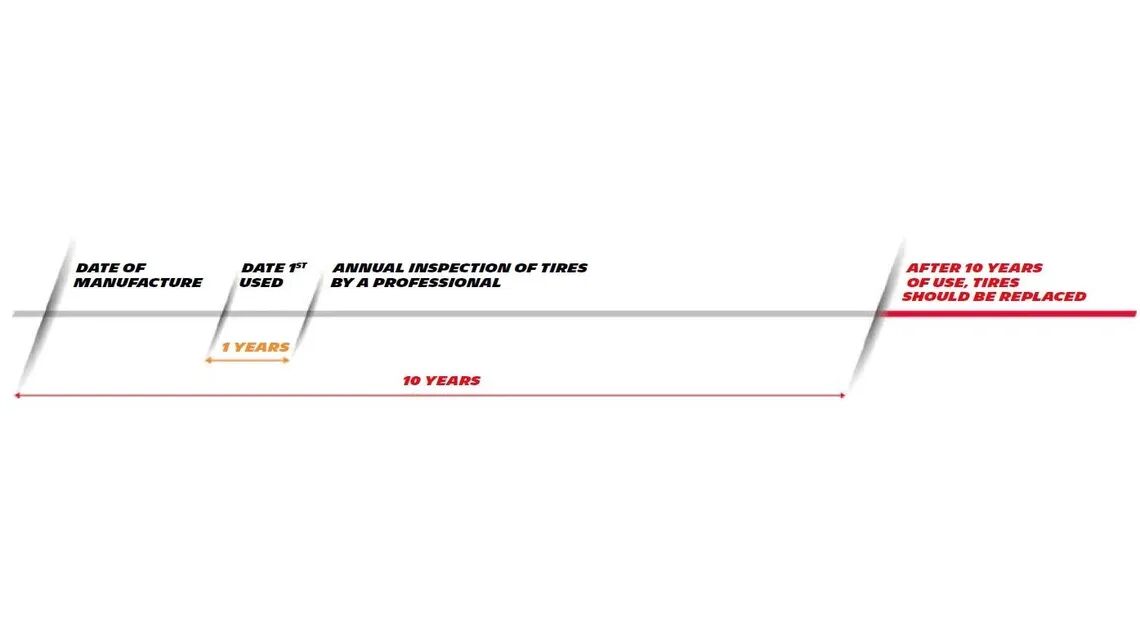When to change motorcycle tyres?
Tyres in poor condition can ruin your vehicle's performance and even endanger your safety or that of your loved ones. It is therefore recommended that you do a monthly inspection to check:
The state of the tyres
Wear indicators
Any damage due to impacts or any sign of unusual wear
The tyre pressure
When making visual checks, pay particular attention to the tread area and the sidewalls. Look for unusual, excessive, or uneven tread wear, foreign objects, bulges or deformation, signs of penetration, cracking of the rubber or any deterioration or damage.
If the tyre has a puncture
Tyres are durable and are designed to withstand a certain number of impacts, but they can sometimes get a puncture. In the event of a flat tyre, the tyre should be inspected by a professional. Only he will be able to confirm that the tyre's interior chamber hasn't suffered any irreparable damage.
If the legal tread wear limit has been reached
Motorcycle tyre wear occurs for all tyres over time. Care should be taken not to exceed the legal wear limit.
The wear indicators on the tyre are 0.8 mm high. This height is strictly the same for all tyres.
Although the wear indicators provide information on the level of wear, it is important to know that this is an indicative value which does not always reflect the legislation. Indeed, the official legal limit may vary according to the legislation of each country. For example, in France, the legal limit is 1mm, whereas in Switzerland it is 1.6mm.
How to identify motorcycle tyre wear indicators?
A Michelin Man symbol on the upper side of your tyres means that they feature a tread wear indicator. Similar to little bumps, these can be found at the bottom of the main grooves.
1 - Identify the Michelin Man symbol
2 - Find the closest motorcycle tyre wear indicator in a main groove
Once the remaining rubber has worn down to this level, the tyre has reached or exceeded its legal wear limit. Although Michelin tyres are designed for performance made to last, we strongly advise you to change your tyres before reaching this point. Past this point, your safety cannot be guaranteed, nor can grip or performance, particularly on wet surfaces.
If tyres show signs of ageing
It is difficult to predict a tyre's lifespan because it bears no relation to its manufacturing date. Tyres that have never been used, or have only been used infrequently, may still show signs of ageing. Many factors can affect their lifespan: weather conditions, storing and usage conditions, load, speed, tyre pressure, maintenance, riding style...
Michelin recommends that all riders regularly dedicate a few moments of their time to inspecting their tyres in order to pick up on any external signs of ageing or wear: deformations or cracks in the tread, on the shoulders or sides...
You should also have your tyres checked by a professional who can assess if they should be replaced or not.
How long do motorcycle tyres last?

After 5 years of use or more, tyres should be examined every year by a professional. If the tyres need to be changed, follow the manufacturer's recommendations with regard to replacing original components. As a precaution, all tyres that have not been replaced after ten years should be changed, even if they appear to be in a generally good condition and have not reached their tread wear limit.
If the tyre is damaged
Pavements, holes or blunt objects can seriously damage tyres. All tears, cuts or deformations should be carefully examined by a professional. Only a professional can confirm whether the tyre can be repaired. As a general rule, don't ride on damaged or flat tyres.
When is a tyre damaged beyond repair?
A tyre cannot be repaired in the following cases:
Punctures to the sides of the tyre (repair is only possible in the T area, which is 3/4 of the width of the tyre)
Visible beads
The tread rubber becoming unstuck or deformed
Degradation showing parts of the interior of the tyre
Damage due to oils or corrosive substances
Cracking of the rubber due to ageing of the tyre
Here are some examples of damage requiring professional intervention:
Cracks
Small visible lines or fractures that appear on the tyre’s surface, usually caused by ageing, UV exposure, or under-inflation. It is critical to note that this degradation can weaken the rubber and reduce grip, making your tyre less safe and less durable over time.
Splits
Deeper cuts or openings in the tyre structure, often the result of heavy impact, curbs, or sharp debris. Splits can expose inner layers of the tyre, leading to air loss or sudden failure, and should be checked and replaced immediately.
Marble
Small, round rubber balls that form on the tyre edges after aggressive cornering or high-temperature riding. This is a result of the rubber overheating and shedding unevenly, reducing traction and stability on the track or road
If the tyre shows an unusual pattern of wear
Unusual motorcycle tyre wear on the treads - localised in certain places, in the centre or on the shoulders - is often a sign of an incorrect tyre pressure. An overinflated tyre will cause more wear in the centre of the tyre, while an underinflated tyre will cause more wear on the shoulders, which can damage the carcass inside the tyre over time. To avoid this, check your tyre pressure regularly so that it corresponds to that recommended by the manufacturer.
Another cause of irregular motorcycle tyre wear and tear may be that of a mechanical problem (worn shock absorbers, transmission, fixings…) or very sporty driving.
If you have any doubts, contact a professional.
If you have the wrong tyres for your vehicle
Choose your tyres in accordance with legal requirements and manufacturer's homologations.
For optimal performance, preferably use the same brand and range of tyres at the front and rear. Never fit a vehicle with one radial tyre and one non radial tyre unless specified by the manufacturer. The best way to ensure you have the right tyres is to follow the manufacturer's homologations.
When the time comes to change your tyres, check out our tyre selector below to be sure you make the right choice or ask a professional for advice.


